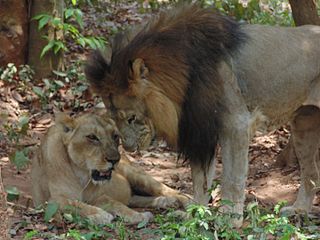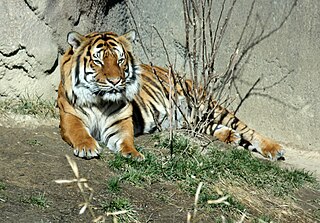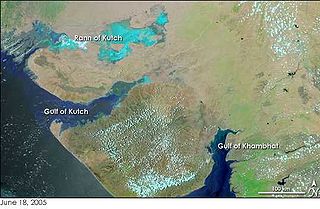
The tiger is the largest living cat species and a member of the genus Panthera. It is most recognisable for its dark vertical stripes on orange fur with a white underside. An apex predator, it primarily preys on ungulates, such as deer and wild boar. It is territorial and generally a solitary but social predator, requiring large contiguous areas of habitat to support its requirements for prey and rearing of its offspring. Tiger cubs stay with their mother for about two years and then become independent, leaving their mother's home range to establish their own.

The lion is a large cat of the genus Panthera native to Africa and India. It has a muscular, broad-chested body; short, rounded head; round ears; and a hairy tuft at the end of its tail. It is sexually dimorphic; adult male lions are larger than females and have a prominent mane. It is a social species, forming groups called prides. A lion's pride consists of a few adult males, related females, and cubs. Groups of female lions usually hunt together, preying mostly on large ungulates. The lion is an apex and keystone predator; although some lions scavenge when opportunities occur and have been known to hunt humans, lions typically do not actively seek out and prey on humans.
The term "big cat" is typically used to refer to any of the five living members of the genus Panthera, namely the tiger, lion, jaguar, leopard, and snow leopard, as well as the non-pantherine cheetah and cougar.

The Bengal tiger is a population of the Panthera tigris tigris subspecies and the nominate Tiger subspecies. It ranks among the biggest wild cats alive today. It is considered to belong to the world's charismatic megafauna.

Gir National Park and Wildlife Sanctuary, also known as Sasan Gir, is a forest, national park, and wildlife sanctuary near Talala Gir in Gujarat, India. It is located 43 km (27 mi) north-east of Somnath, 65 km (40 mi) south-east of Junagadh and 60 km (37 mi) south-west of Amreli. It was established in 1965 in the erstwhile Nawab of Junagarh's private hunting area, with a total area of 1,410.30 km2 (544.52 sq mi), of which 258.71 km2 (99.89 sq mi) is fully protected as a national park and 1,151.59 km2 (444.63 sq mi) as wildlife sanctuary. It is part of the Khathiar-Gir dry deciduous forests ecoregion.

The Caspian tiger was a Panthera tigris tigris population native to eastern Turkey, northern Iran, Mesopotamia, the Caucasus around the Caspian Sea, Central Asia to northern Afghanistan, and the Xinjiang region in western China. Until the Middle Ages, it was also present in Ukraine and southern Russia. It inhabited sparse forests and riverine corridors in this region until the 1970s. This population was regarded as a distinct subspecies and assessed as extinct in 2003.

The Asiatic lion, also known as the Persian lion, is a population of Panthera leo leo that today survives in the wild only in India. Since the turn of the 20th century, its range has been restricted to Gir National Park and the surrounding areas in the Indian state of Gujarat. Historically, it inhabited much of southwest Asia to northern India.

Panthera leo leo is a lion subspecies, which is present in West Africa, northern Central Africa and India. In West and Central Africa it is restricted to fragmented and isolated populations with a declining trajectory. It has been referred to as the Northern lion.

The Khathiar–Gir dry deciduous forests is a mostly arid ecoregion in northwestern India that stretches over 103,100 sq mi (267,000 km2) across Gujarat, Rajasthan and Madhya Pradesh. The dry deciduous forests in the region are dominated by teak, and thorny trees and scrub in drier areas.
A Panthera hybrid is a crossbreed between individuals of any of the five species of the genus Panthera: the tiger, lion, jaguar, leopard, and snow leopard. Most hybrids would not be perpetuated in the wild as the territories of the parental species do not overlap and the males are usually infertile. Mitochondrial genome research revealed that wild hybrids were also present in ancient times. The mitochondrial genomes of the snow leopard and the lion were more similar to each other than to other Panthera species, indicating that at some point in their history, the female progeny of male ancestors of modern snow leopards and female ancestors of modern lions interbred with male ancestors of modern snow leopards.

The Malayan tiger is a tiger from a specific population of the Panthera tigris tigris subspecies that is native to Peninsular Malaysia. This population inhabits the southern and central parts of the Malay Peninsula and has been classified as critically endangered on the IUCN Red List since 2015. As of April 2014, the population was estimated at 80 to 120 mature individuals with a continuous declining trend.

The Indian leopard is a leopard subspecies widely distributed on the Indian subcontinent. The species Panthera pardus is listed as Vulnerable on the IUCN Red List because populations have declined following habitat loss and fragmentation, poaching for the illegal trade of skins and body parts, and persecution due to conflict situations. The Indian leopard is one of the big cats occurring on the Indian subcontinent, along with the Asiatic lion, Bengal tiger, snow leopard and clouded leopard. In 2014, a national census of leopards around tiger habitats was carried out in India except the northeast. 7,910 individuals were estimated in surveyed areas and a national total of 12,000–14,000 speculated.
Mukundara Hills National Park is a national park in Rajasthan, India with an area of 759.99 km2 (293.43 sq mi). It was established in 2004 and consists of three wildlife sanctuaries: Darrah Wildlife Sanctuary, National Chambal Sanctuary, and Jawahar Sagar Wildlife Sanctuary. It is located in the Khathiar-Gir dry deciduous forests.
Kuno National Park is a national park and Wildlife Sanctuary in Madhya Pradesh, India. It derives its name from Kuno River. It was established in 1981 as a wildlife sanctuary with an initial area of 344.686 km2 (133.084 sq mi) in the Sheopur and Morena districts. In 2018, it was given the status of a national park. It is part of the Khathiar-Gir dry deciduous forests ecoregion.

The Asiatic Lion Reintroduction Project is an initiative of the Indian Government to provide safeguards to the Asiatic lion from extinction in the wild by means of reintroduction. The last wild population of the Asiatic lion is found in the region of Gir Forest National Park, in the state of Gujarat. The single population faces the threats of epidemics, natural disasters and other anthropogenic factors. The project aims to establish a second independent population of Asiatic lions at the Kuno National Park in the Indian state of Madhya Pradesh. However, the proposed translocation has been bitterly contested by the state government.
India is home to a large variety of wildlife. It is a biodiversity hotspot with various ecosystems ranging from the Himalayas in the north to the evergreen rain forests in the south, the sands of the west to the marshy mangroves of the east. India lies within the Indomalayan realm and is the home to about 7.6% of mammal, 14.7% of amphibian, 6% of bird, 6.2% of reptilian, and 6.2% of flowering plant species. India's forests contain about 500 species of mammals and more than 2,000 bird species.

Cheetah reintroduction in India involves the attempt to introduce and sustain a small population of Southeast African cheetah in India more than 70 years after India's native subspecies, the Asiatic cheetah became extinct there; the Asiatic subspecies is now found only in Iran in critically endangered numbers.

A tigon, tiglon, or tion is the hybrid offspring of a male tiger and a lioness. They exhibit visible characteristics from both parents: they can have both spots from the mother and stripes from the father. Any mane that a male tigon may have will appear shorter and less noticeable than a lion's mane and is closer in type to the ruff of a male tiger.

Parishan Lake is a lake in Iran. The Parishan Lake is in Jereh and Baladeh District in Fars Province and is the largest freshwater lake in the country. It receives only very small amount of water from feeder rivers and the whole lake or wetland is a protected area, as it is considered a globally significant wetland ecosystem.

The Gulf of Khambhat, historically known as the Gulf of Cambay, is a bay on the Arabian Sea coast of India, bordering the state of Gujarat just north of Mumbai and Diu Island. The Gulf of Khambhat is about 200 km (120 mi) long, about 20 km (12 mi) wide in the north and up to 70 km (43 mi) wide in the south. Major rivers draining Gujarat are the Narmada, Tapti, Mahi and the Sabarmati, that form estuaries in the gulf.






















